in the national interest
May 7 - June 10, 2006
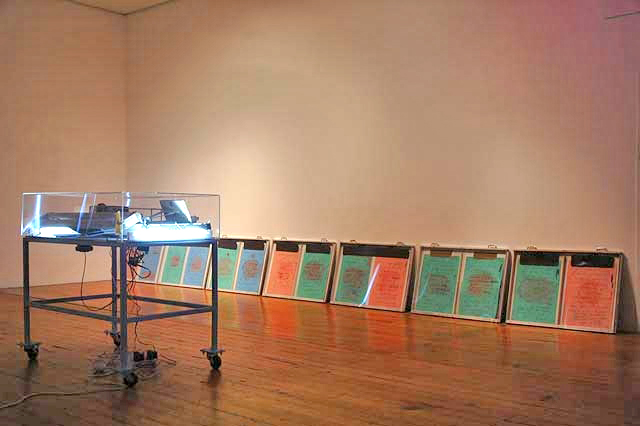 in the national interest - installation view
in the national interest - installation view
One of the most remarkable things about et al's work is the inability of the spectator to worship at the altar; one can only ponder and contemplate the physical object. This seems quite relevant when we situate 'in the national interest' in an era that thrives on both pseudo-intellectualism and exhausted nostalgia. et al has struck on the quintessential nature of contemporary practice, redirecting our attention to the difficulty of interpretation, the instability of modern truths in a time of doubt and discord. Themes in 'the national interest' include those of time and renewal, questions of originality and homage that are consistently used and reused, and reinvented again today.
When we study l budd's work in the context of et al's project for the 2005 Venice Biennale, one cannot help but contextualize what Rob Storr said, upon presenting the coveted Walter's prize to et al. Storr spoke of the collective's work as art that is resistant to the viewer yet ultimately gratifying as it calls you to 'Come to me, I will engage you in a process of figuring out what I am, and who you are.' Perhaps what Storr means, in a less dramatic fashion is that when you try to understand et al's work you begin to understand the nature of yourself. This is a frightening but exhilarating concept to explore. Viewers go into 'the national interest' peering at the white washed artifacts and ask, where am I in this blankness? And how do I begin?
l budd's work encompasses the romantic and the bleak. 'in conversation with the artists' deals with the quintessential problem of language and the gap between meaning and words, always found in the blurriness of the in-between or the trembling nature of communication. Budd's work re-registers the nature of reality, reserving for us the concept that the only thing we can be sure of is that all communication and language is doubt immersed. l budd forces us to reach in without pretensions and simply read.
Writers and art reviewers obediently fall into line with this notion. With et al notoriously closemouthed about the work, writers and reviewers have resorted to literature as a lens and way of reading into the collective. Natasha Conland reads et al's work through the lens of Saramago's text Blindness, while Andrew Paul Wood playfully compares it to a Greek meridian chorus of voices.
Budd's readymade monomime pastel panels currently lean up against the front room of the Jonathan Smart Gallery. Sixteen paper sheets painted pink, blue and green are lovingly enframed in old steel drawers with perspex tops. The sheets of paper register narratives that speak with urgency and clarity, to the extent that words are crossed out to make their message even clearer. Hence, 'instinct' is crossed out to make room for 'spirit,' and 'destroys' is underlined to illuminate 'herself.' Indeed this sense of erasure, this play of presence against absence has long been characteristic of the et al aesthetic.
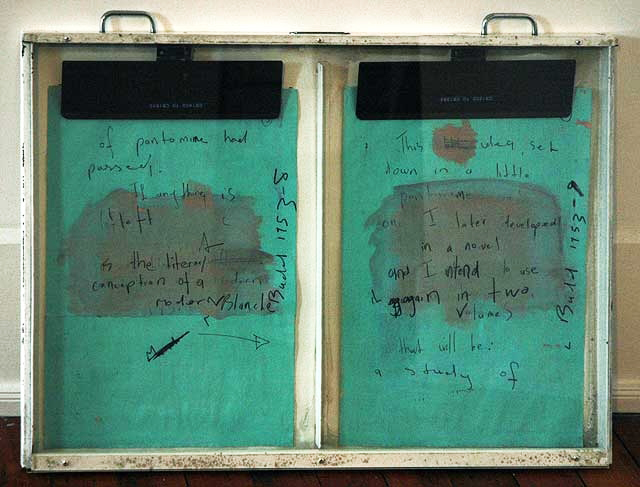 the artists in conversation (detail)
the artists in conversation (detail)Budd has created a work resplendent in contradictions. The vitrines are painted over with a white blankness refusing entry into neurological brain texts, yet promising a lightness encapsulated in the indolent twittering of the birds surrounding the room. Budd's work is pared down stark, yet vivid hued and brimming with life. Similarly the vitrine's commentary, the bird calls, necessitate color which their perspex enclosures and fluorescent lights defer into white blindness. The installation then, is both old and new, the text at times joyful yet melancholic, while also reworking old questions which are crossed out and reinvented anew.
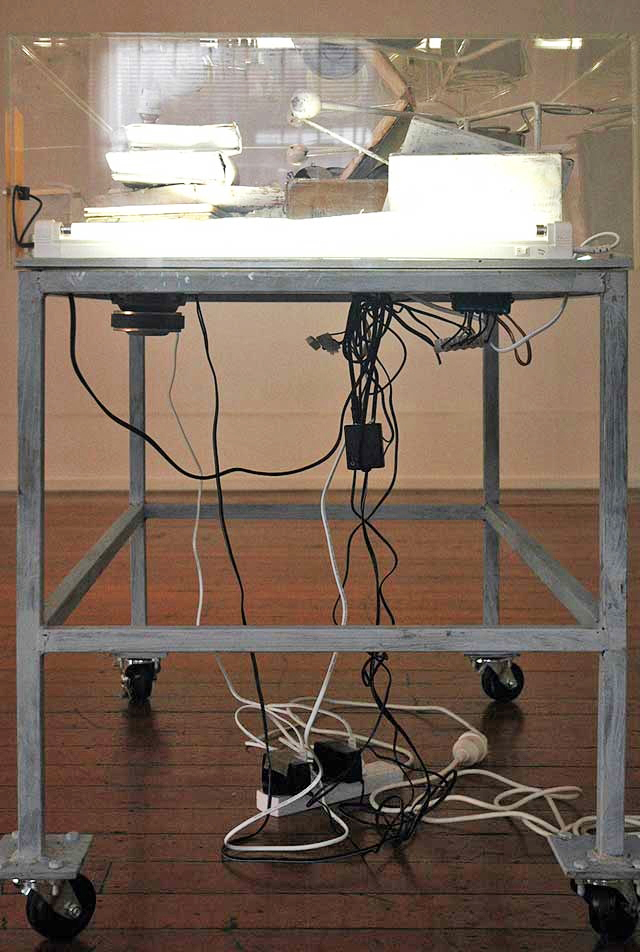 |
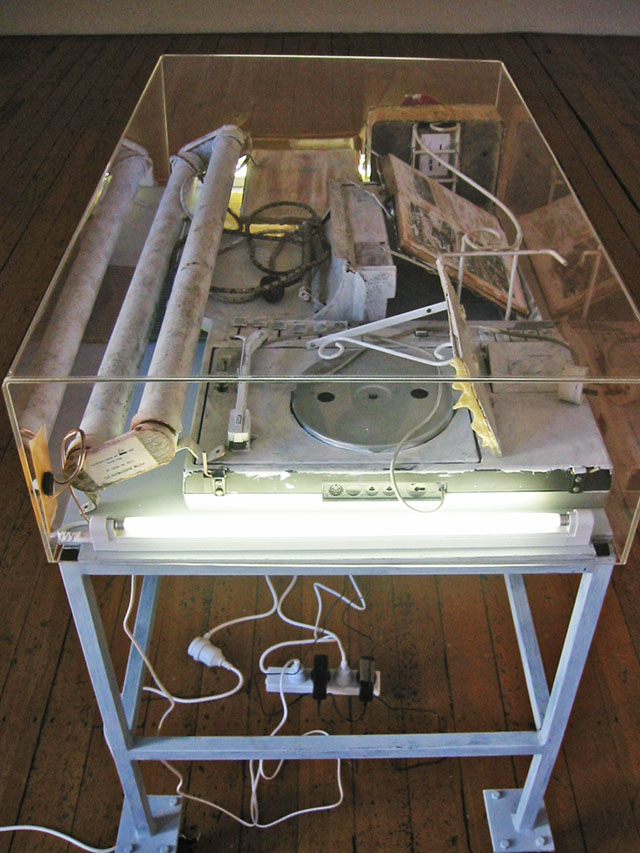 |
| vitrines |
|
Mark Kramer refers to et al's work as a broker in shadows, one who uses dead technology and grey paint to manifest an almost sinister paleness that criticizes the light. 'in the national interest' readdresses this criticism. At it's lightest we refer to it as playful and at it's most profound, we see it as a brief sadness, translucent grief easily swept and frittered away. This does not diminish the profundity of the work but pays tribute and tragedy to the brief mourning of human sorrow and joy.
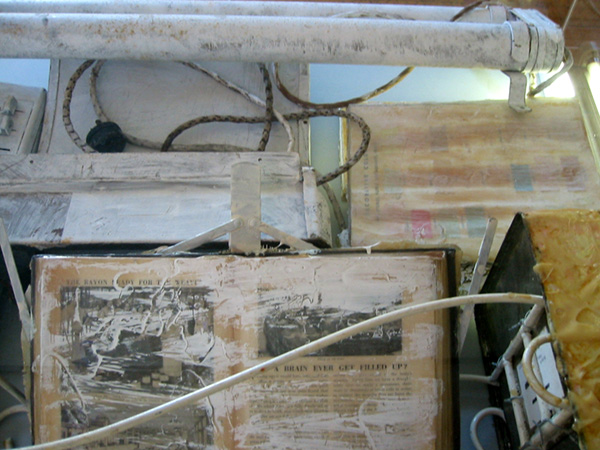 vitrines - detail
vitrines - detailIn these semi-opaque shadows we ponder the other relevant theme of pantomime. We are faced, not surprisingly with Shakespeare and the workings of a poor actor, alone on stage, signaling with empty gestures. For this is the secret melancholy of et al's work, the idea that all attempted searches for meaning leave us somewhat entertained and rejuvenated but never replace that small doubt of disbelief, the cynicism that reduces us to empty gestures on a dark stage. Macbeth disintegrates in proclaiming that Life perhaps, was nothing more than a hostile noise, a tale told by an idiot, full of sound and fury and signifying nothing but silence. In Budd's work, after the storm, there is not silence but the twittering of birds.
Melissa Lam





